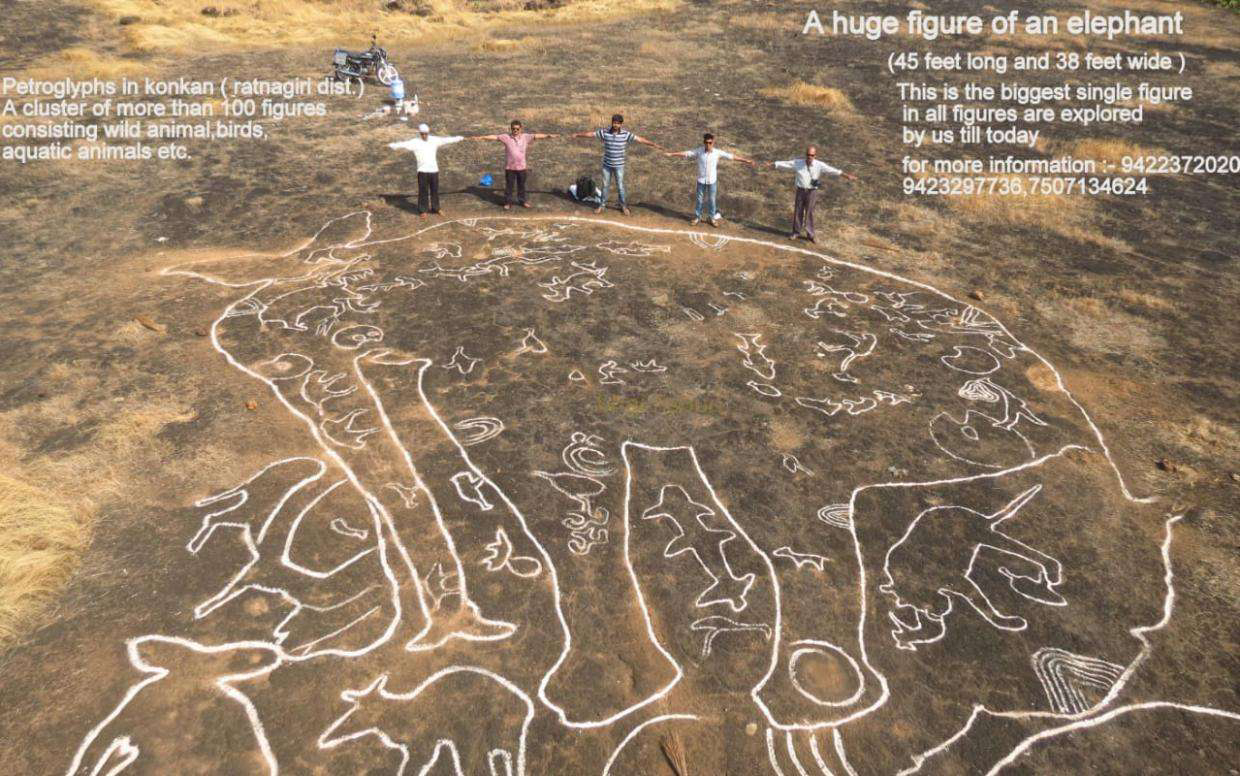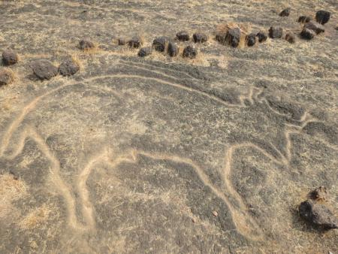
We all are humans and we all are mortals, we enter this world, grow and then untimely die. And the only element of us which resides afterwards is our legacy of literature and artworks. Just like humans, even towns, literature and creations get demolished, drowned, and evacuated by the passing time. But somehow, some civilizations and their legacy survive in the surge of time. In India civilizations like Dholavira, Lothal and Kaibangan are well known and their sculptures are widely popular. But we cannot overlook the sculptures which are elegantly engraved on the open and massive lateritic plateaus in Ratnagiri, Maharashtra. One cannot even notice these mystic arts on surfaces even after standing on them, because of their complex pattern and massive size.

No one knows about the origin of this rock art and to which civilization it belongs to. The word ‘rock art’ generally gives rise to the idea of pictographs, creations on rocks by using natural colours. But this new finding is a ‘petroglyph’, which is an image carved and scratched into the open rock surface. Petroglyphs reflect the ancient icons of communication, barriers and recollect the happenings of the regional history and rituals. There is a massive sculpture of an elephant with numerous other wild beasts carved inside the elephant, without a single domestic animal in Ukshi village of north Ratnagiri, where a circular viewing passage has been assembled in 2018, along with a note that clarifies the prestige of this artwork. The carving indicates that it can be from the ancient period and this unique finding is determined to provide fresh visions into the early history of the region.

This newfound sculpture is one of the petroglyphs that have been excavated in Ratnagiri and Rajapur district of Maharashtra. From essential descriptions of human and animal forms to a stunning 50ft carving of an elephant, within which a series of minor creatures and aquatic shapes were drawn. More than 280 sculptures have been found in Rajapur, and Lanja in the Ratnagiri district. And now it has become one of the most crucial archaeological sites of recent times by carving sites across the region. At numerous places, the extent of the carvings of animals like elephants and tigers are as big as the actual creatures. Moreover, there are carvings of a crocodile, tortoise, fishes, and snakes. But human carvings are in most of the sculptures, including some geometrical shapes. These massive rock carvings are carved on lateritic rocks of Konkan region during the pre-historic period.

Some well-known petroglyph and rock art locations in India that could be concurrent to this era are the rock carvings in Mirzapur in Uttar Pradesh, Bhimbetka rocks in Madhya Pradesh and many others. The laterite stone carvings make this petroglyph in Konkan region rare, as the carvings found in other locations in India are on granite and sandstone. Newly, petroglyphs of a related aspect, have been uncovered in Sindhudurg district and Goa. These both are at the south of Ratnagiri, hinting at a pattern of migration of civilizations. However, it is not yet evident to any civilization, as there is no indication of agricultural, economic activity and specific territories.
All the credit for this extraordinary discovery belongs to a few explorers led by Sudhir Risbood and Manoj Marathe, who started up digging through the portraits intensely after identifying a few in the region. Many were found in temples and played a major part in local mythology. In an interview with BBC, the director of the Maharashtra State Archaeological Department, Tejas Garge, notified that “Our first deduction from examining these petroglyphs is that they were created around 10,000 BC.” These people have solely researched these sculptures and created an unpublishable record of them. They also have noted the sameness and variations found in the sculptures with their hard work.

These beautiful and incredible ruins of unidentified civilization have incited the visions of numerous researchers, but these places are not well recognized in the state and the country. Presently, the state government of Maharashtra has set aside Rs. 24 crore for additional exploration on these locations and a lot of managerial function still requires to be performed if they are to be showcased as tourist interests. And for a good start, these sites require to be announced as archaeological heritage of the region.
No one knows who carved these mysterious sculptures on these plateaus and what did our ancestors intend to tell us through these sculptures. Although its official information is not available today, more exploration is being conducted by researchers. The purpose of this carving is yet undiscovered. Many of the sculptures are unfinished but most of them have been carved plainly and elegantly. All these arts which contain numerous beasts, birds and ancient patterns are incredibly unusual, and eventually, they are a stunning man-made creation.
(Source - BBC/ ratnagiritourism.in/ nytimes.com)
